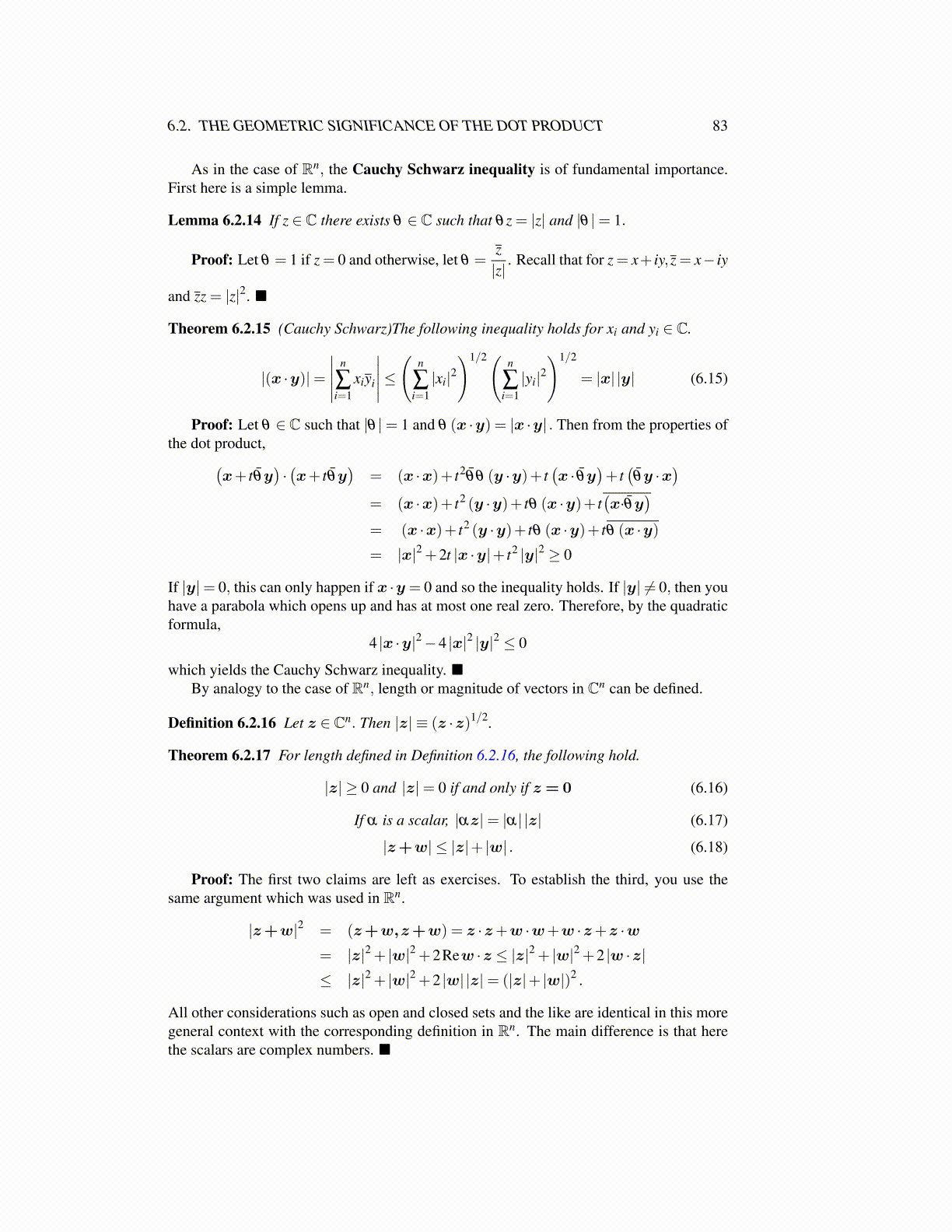
6.2. THE GEOMETRIC SIGNIFICANCE OF THE DOT PRODUCT 83
As in the case of Rn, the Cauchy Schwarz inequality is of fundamental importance.First here is a simple lemma.
Lemma 6.2.14 If z ∈ C there exists θ ∈ C such that θz = |z| and |θ |= 1.
Proof: Let θ = 1 if z = 0 and otherwise, let θ =z|z|
. Recall that for z = x+ iy,z = x− iy
and zz = |z|2. ■
Theorem 6.2.15 (Cauchy Schwarz)The following inequality holds for xi and yi ∈ C.
|(x ·y)|=
∣∣∣∣∣ n
∑i=1
xiyi
∣∣∣∣∣≤(
n
∑i=1|xi|2
)1/2( n
∑i=1|yi|2
)1/2
= |x| |y| (6.15)
Proof: Let θ ∈ C such that |θ |= 1 and θ (x ·y) = |x ·y| . Then from the properties ofthe dot product,(
x+ tθ̄y)·(x+ tθ̄y
)= (x ·x)+ t2
θ̄θ (y ·y)+ t(x · θ̄y
)+ t(θ̄y ·x
)= (x ·x)+ t2 (y ·y)+ tθ (x ·y)+ t
(x·θ̄y
)= (x ·x)+ t2 (y ·y)+ tθ (x ·y)+ tθ (x ·y)= |x|2 +2t |x ·y|+ t2 |y|2 ≥ 0
If |y|= 0, this can only happen if x ·y = 0 and so the inequality holds. If |y| ̸= 0, then youhave a parabola which opens up and has at most one real zero. Therefore, by the quadraticformula,
4 |x ·y|2−4 |x|2 |y|2 ≤ 0
which yields the Cauchy Schwarz inequality. ■By analogy to the case of Rn, length or magnitude of vectors in Cn can be defined.
Definition 6.2.16 Let z ∈ Cn. Then |z| ≡ (z ·z)1/2.
Theorem 6.2.17 For length defined in Definition 6.2.16, the following hold.
|z| ≥ 0 and |z|= 0 if and only if z = 0 (6.16)
If α is a scalar, |αz|= |α| |z| (6.17)
|z+w| ≤ |z|+ |w| . (6.18)
Proof: The first two claims are left as exercises. To establish the third, you use thesame argument which was used in Rn.
|z+w|2 = (z+w,z+w) = z ·z+w ·w+w ·z+z ·w= |z|2 + |w|2 +2Rew ·z ≤ |z|2 + |w|2 +2 |w ·z|≤ |z|2 + |w|2 +2 |w| |z|= (|z|+ |w|)2 .
All other considerations such as open and closed sets and the like are identical in this moregeneral context with the corresponding definition in Rn. The main difference is that herethe scalars are complex numbers. ■